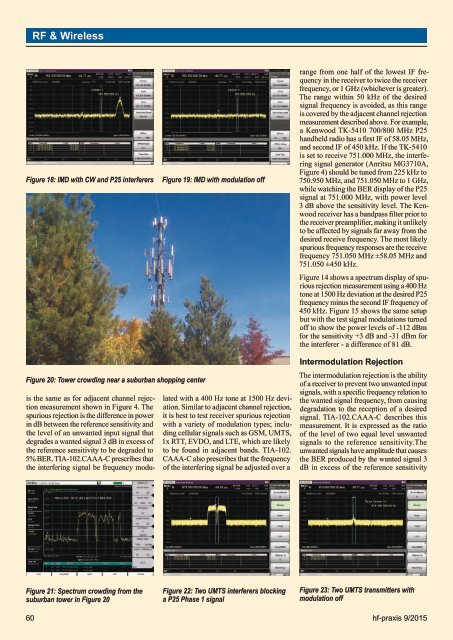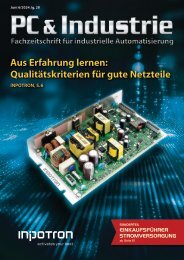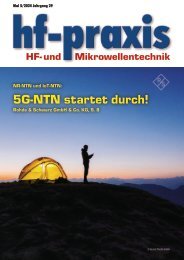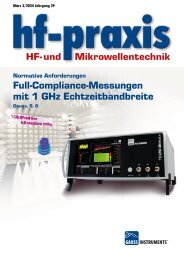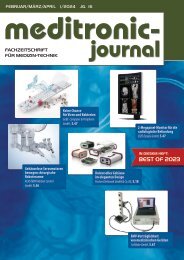9-2015
Fachzeitschrift für Hochfrequenz- und Mikrowellentechnik
Fachzeitschrift für Hochfrequenz- und Mikrowellentechnik
Sie wollen auch ein ePaper? Erhöhen Sie die Reichweite Ihrer Titel.
YUMPU macht aus Druck-PDFs automatisch weboptimierte ePaper, die Google liebt.
RF & WirelessFigure 18: IMD with CW and P25 interferersFigure 19: IMD with modulation offrange from one half of the lowest IF frequencyin the receiver to twice the receiverfrequency, or 1 GHz (whichever is greater).The range within 50 kHz of the desiredsignal frequency is avoided, as this rangeis covered by the adjacent channel rejectionmeasurement described above. For example,a Kenwood TK-5410 700/800 MHz P25handheld radio has a first IF of 58.05 MHz,and second IF of 450 kHz. If the TK-5410is set to receive 751.000 MHz, the interferingsignal generator (Anritsu MG3710A,Figure 4) should be tuned from 225 kHz to750.950 MHz, and 751.050 MHz to 1 GHz,while watching the BER display of the P25signal at 751.000 MHz, with power level3 dB above the sensitivity level. The Kenwoodreceiver has a bandpass filter prior tothe receiver preamplifier, making it unlikelyto be affected by signals far away from thedesired receive frequency. The most likelyspurious frequency responses are the receivefrequency 751.050 MHz ±58.05 MHz and751.050 ±450 kHz.Figure 14 shows a spectrum display of spuriousrejection measurement using a 400 Hztone at 1500 Hz deviation at the desired P25frequency minus the second IF frequency of450 kHz. Figure 15 shows the same setupbut with the test signal modulations turnedoff to show the power levels of -112 dBmfor the sensitivity +3 dB and -31 dBm forthe interferer - a difference of 81 dB.Figure 20: Tower crowding near a suburban shopping centeris the same as for adjacent channel rejectionmeasurement shown in Figure 4. Thespurious rejection is the difference in powerin dB between the reference sensitivity andthe level of an unwanted input signal thatdegrades a wanted signal 3 dB in excess ofthe reference sensitivity to be degraded to5% BER. TIA-102.CAAA-C prescribes thatthe interfering signal be frequency modulatedwith a 400 Hz tone at 1500 Hz deviation.Similar to adjacent channel rejection,it is best to test receiver spurious rejectionwith a variety of modulation types; includingcellular signals such as GSM, UMTS,1x RTT, EVDO, and LTE, which are likelyto be found in adjacent bands. TIA-102.CAAA-C also prescribes that the frequencyof the interfering signal be adjusted over aIntermodulation RejectionThe intermodulation rejection is the abilityof a receiver to prevent two unwanted inputsignals, with a specific frequency relation tothe wanted signal frequency, from causingdegradation to the reception of a desiredsignal. TIA-102.CAAA-C describes thismeasurement. It is expressed as the ratioof the level of two equal level unwantedsignals to the reference sensitivity.Theunwanted signals have amplitude that causesthe BER produced by the wanted signal 3dB in excess of the reference sensitivityFigure 21: Spectrum crowding from thesuburban tower in Figure 20Figure 22: Two UMTS interferers blockinga P25 Phase 1 signalFigure 23: Two UMTS transmitters withmodulation off60 hf-praxis 9/<strong>2015</strong>


